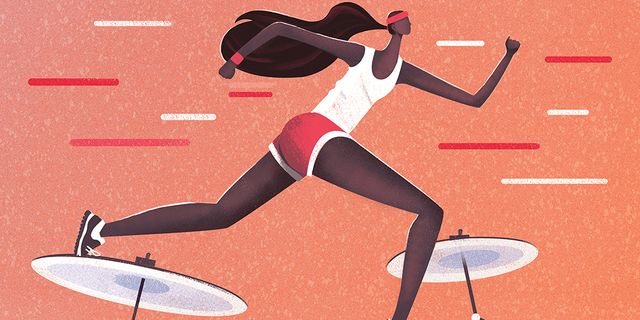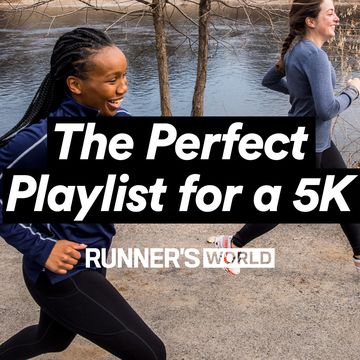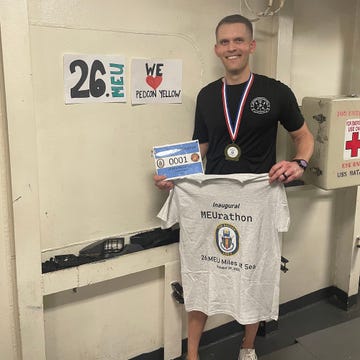Perhaps you’re familiar with the old insult, “She can’t walk and chew gum at the same time.” Said dummy possesses so little brain capacity, goes the logic, that she’s unable to simultaneously complete two activities.
Perhaps you’re also familiar with the concept of running “form”—the proper posture one is meant to maintain while in motion. Your head is supposed to be up, your gaze directed forward and not on your feet, which, incidentally, are supposed to be flexed (from the ankles), then rolling (onto the balls), then lifting (but not too high), then landing (but not too hard). Your torso: erect. Your hands: not fisty. Your shoulders: down. Your elbows: bent at 90 degrees. Your attention: gone three sentences ago.
Perhaps you’re wondering if proper form is attainable. I sure do! I can walk and chew gum at the same time—I mean, it’s been a while, but I’m confident. However, I’m convinced I’ll never learn how to forward-lookingly flex-roll-lift-land while remaining erect, unfisty, drop-shouldered, and right-angled. Why not just ask me to conduct Shostakovich’s Symphony No. 5 while juggling cats and reciting the final lines of “The Love Song of J. Alfred Prufrock”?
But then I remember: Oh yeah, the drums.
In May 2014, plagued by a certain romantic restlessness, I took a free drum lesson at a local music school. I had no special aptitude—that was clear by the end of lesson one—and yet I wound up coming back once a week, and later twice a week, for a year, even though the school served mostly children. (Often when I walked in, I’d find myself surrounded by 10-year-olds, staring up at me with blatant pity.) News flash: The drums are hard. Yet it was sort of fun to be so resoundingly bad at something. The stakes were low. If I screwed up, no one but my teacher noticed. (He was 25, bless his heart. One time he told me I should check out this great singer-songwriter he liked, maybe I’d be into him. It was Paul Simon.)
Here’s why the drums are so damnably difficult: It’s the whole walking-chewing thing, times 8 million. Imagine you’re seated at a drum kit. To your left are, clockwise from your waist, the snare (the rattly sound that backbones every song ever), the hi-hat (a cymbal sandwich you open and close with your foot), the crash (big cymbal), and a tom (small, booming drum). To your right, clockwise from your chest: another tom (slightly more booming), the ride (tinnier cymbal), the floor tom (even boomier), and bass drum (boomingest of all—you hit it with a foot pedal).
Now imagine you’re playing a four-part rock beat, easy as it gets. Your left foot clamps the hi-hat closed. On all four beats, your right hand taps the hi-hat, tink tink tink tink. On beats one and three, your right foot kabooms the bass drum, thunk (pause) thunk (pause). On beats two and four, your left hand pelts the snare, (pause) thwack (pause) thwack—but make sure you’re using your wrist, not your arm! And let the stick’s tip bounce, don’t drive it into the drum’s skin! And listen for your cue to start the chorus, in which you wail on the crash instead of the hi-hat! And when you bash your head against the wall in frustration, try not to lose consciousness—that 4-year-old in the hall needs the room to practice “Moby Dick.” He’s really into Zeppelin lately!
The point is that drumming and running both boil down to a maddening kind of multitasking—the kind that makes your brain want to jump out of your skull and then explode. Telling each hand and foot to do something different on a drum kit is asking your mind to cleave itself into quarters. (It’s about as pleasant, too.)
Which is why you have to clear your head and shift to muscle memory. In drumming and running, you have to do like Don Draper: “Think deeply about it, then forget it.” Break each step (or beat) into chunks. Practice each chunk ad nauseam. And then never, ever think about the chunks in the moment.
I’m now a good drummer. All that brain-splitting stuff that once felt impossible is old hat. (Old hi-hat, as it were.) I used to learn songs by writing out what each beat required. Beat one: hi-hat/kick drum. Beat two: hi-hat/snare. And so on. Play that beat at a snail’s pace. Then go a little faster. Then a little faster than that. Then at the correct tempo. With my running form, I applied the same principle. I stood in my living room and moved only my arms—90-degree-angled elbows, shoulders loose, hands unclenched. After 10 ridiculous minutes of this, my body’s not going to forget the feel of that arm position anytime soon.
Repeat with feet and torso. Add it all together, properly positioned body part by properly positioned body part. Don’t try to mastermind the operation—let each piece of you remember what it’s supposed to do, and allow your mind to be empty, only dimly conscious of the extraordinary feat it’s accomplishing.
Then: Get out and rock this thing.
* * *
Kathryn Arnold is a writer in New York City. She’s written for Time, New York, Slate, and Wired and is the author of the novel Bright Before Us (2011). She is, actually, a fan of Paul Simon.













